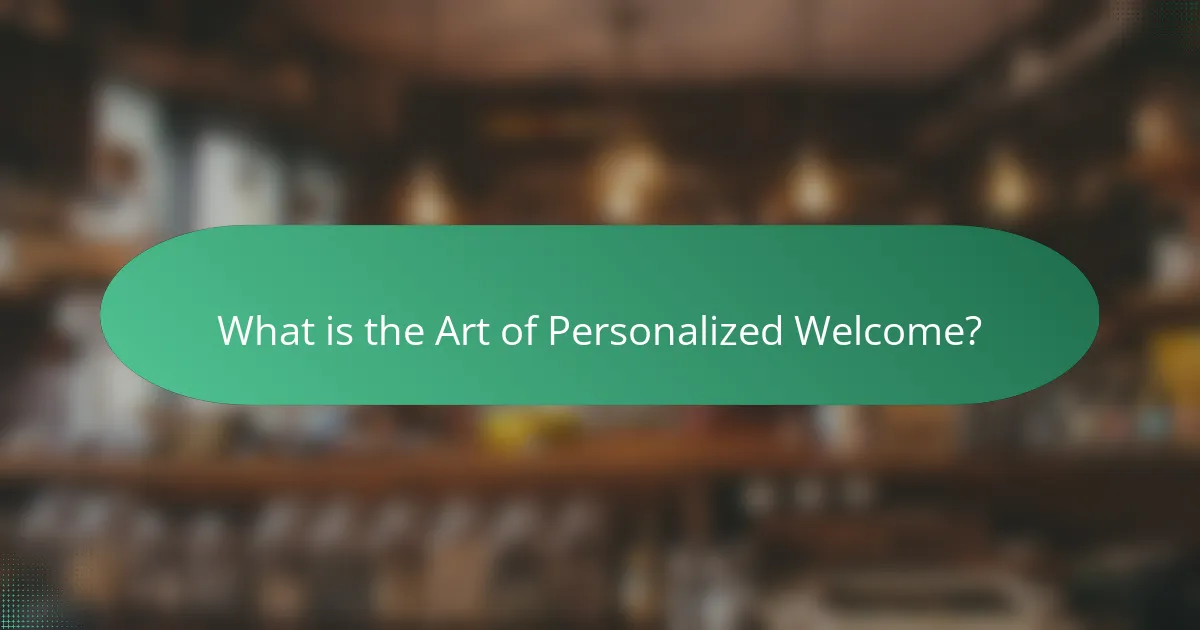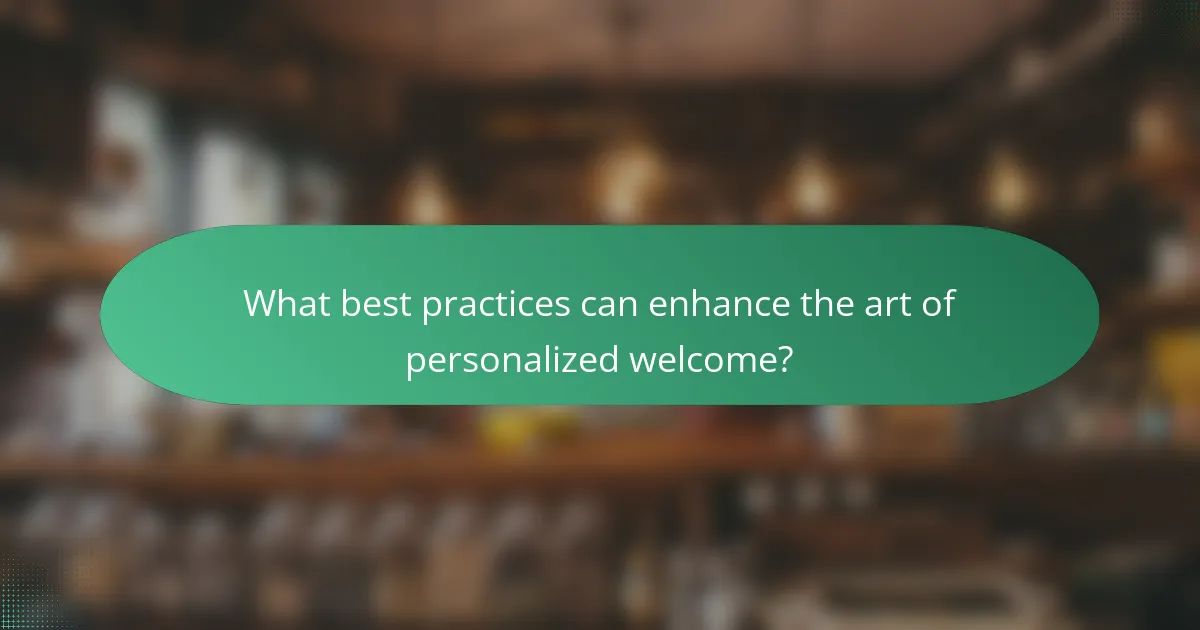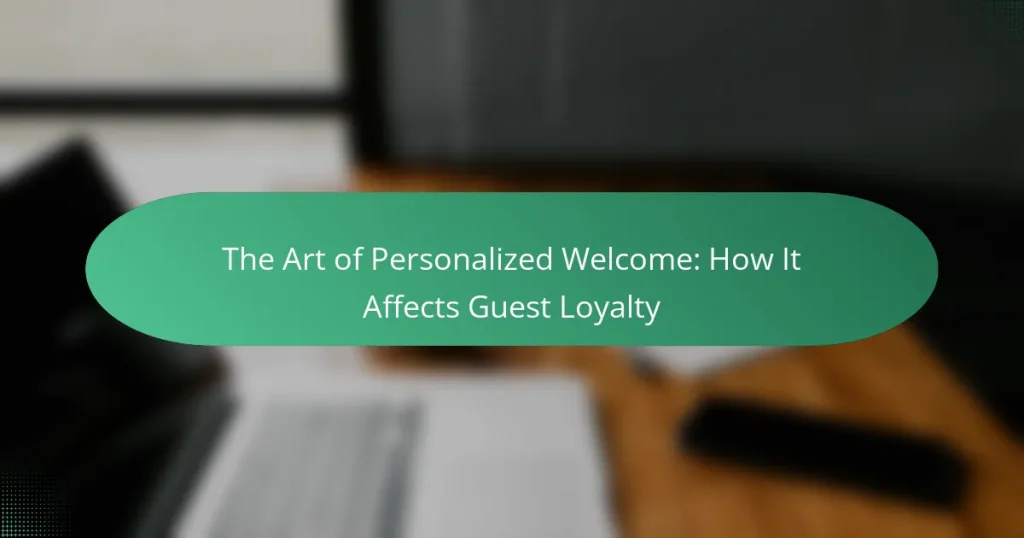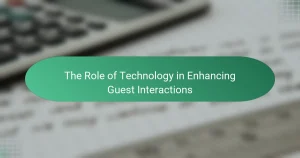The Art of Personalized Welcome focuses on the tailored greeting of guests in the hospitality industry to enhance their experience and foster loyalty. Key components of this practice include addressing guests by name, acknowledging their preferences, and maintaining a warm tone. Research indicates that personalized interactions significantly improve guest satisfaction and loyalty, ultimately impacting revenue. Best practices for implementing personalized welcomes involve understanding guest preferences, providing customized experiences, and utilizing technology for effective tracking of guest information. Continuous staff training and feedback collection are essential for improving personalized service and ensuring guests feel valued throughout their stay.

What is the Art of Personalized Welcome?
The Art of Personalized Welcome is the practice of greeting guests in a tailored manner. This approach enhances the guest experience by making individuals feel valued and recognized. Personalized welcomes can include using a guest’s name, recalling previous visits, or acknowledging preferences. Research shows that personalized interactions significantly increase guest satisfaction. A study by the Cornell University School of Hotel Administration found that personalized service boosts customer loyalty and repeat visits. This art form is crucial in the hospitality industry, where guest loyalty directly impacts revenue.
How does a personalized welcome enhance the guest experience?
A personalized welcome enhances the guest experience by creating an immediate connection. This connection fosters a sense of belonging. Guests feel valued when their preferences and names are acknowledged. Research shows that personalized interactions can increase guest satisfaction by up to 20%. A study by the Cornell University School of Hotel Administration found that personalized service leads to higher loyalty. Guests are more likely to return to establishments where they feel recognized. This ultimately drives repeat business and positive word-of-mouth referrals. Personalized welcomes can differentiate a brand in a competitive market.
What specific elements contribute to a personalized welcome?
A personalized welcome includes several specific elements. These elements are tailored greetings, guest name usage, and individualized service. Tailored greetings create an immediate connection. Using the guest’s name enhances the personal touch. Individualized service reflects attention to the guest’s preferences. According to research, 70% of consumers prefer personalized experiences. This preference directly impacts their loyalty to brands. Personalization fosters a sense of belonging and recognition. This approach significantly enhances guest satisfaction and retention.
How can personalization be tailored to different guest preferences?
Personalization can be tailored to different guest preferences through data collection and analysis. Hotels can gather information on guests’ past stays, preferences, and feedback. This data can include room types, amenities, dining preferences, and activities enjoyed. By analyzing this information, hotels can create personalized experiences that cater to individual tastes. For example, a guest who prefers a specific type of pillow can have that waiting in their room. Additionally, personalized communication, such as addressing guests by name and offering tailored recommendations, enhances the experience. Research shows that 80% of consumers are more likely to make a purchase when brands offer personalized experiences. This reinforces the importance of personalization in fostering guest loyalty.
Why is guest loyalty important in the hospitality industry?
Guest loyalty is crucial in the hospitality industry because it drives repeat business and enhances profitability. Loyal guests tend to spend more during their visits. They also recommend the establishment to others, increasing its customer base. According to a study by Bain & Company, increasing customer retention rates by 5% can lead to a profit increase of 25% to 95%. Additionally, loyal guests often require less marketing investment compared to acquiring new customers. This leads to lower operational costs and higher overall efficiency. Therefore, fostering guest loyalty is essential for long-term success in the hospitality sector.
What factors contribute to building guest loyalty?
Key factors contributing to building guest loyalty include personalized service, consistent quality, and emotional connection. Personalized service enhances the guest experience by making individuals feel valued. Consistent quality ensures that guests receive the same high standard every time they visit. Emotional connection fosters a sense of belonging, encouraging guests to return. Research shows that 70% of consumers say a good experience is more likely to drive their loyalty than price. Additionally, 86% of buyers are willing to pay more for a great customer experience. These statistics highlight the importance of focusing on these factors to cultivate loyalty effectively.
How does a personalized welcome influence guest retention rates?
A personalized welcome significantly enhances guest retention rates. When guests receive a tailored greeting, it fosters a sense of belonging. This emotional connection encourages guests to return. Research shows that 70% of consumers prefer personalized experiences. Moreover, personalized welcomes can increase customer satisfaction by 20%. This satisfaction often translates into loyalty. Guests who feel valued are more likely to recommend the service. Thus, a personalized welcome directly correlates with higher retention rates.

What are the key components of a successful personalized welcome?
A successful personalized welcome includes several key components. First, it must address the guest by name. This creates an immediate personal connection. Second, it should acknowledge the guest’s preferences or past interactions. Recognizing previous visits enhances the feeling of being valued. Third, it is essential to offer a warm and friendly tone. A genuine smile or enthusiastic greeting can set a positive atmosphere. Fourth, providing tailored recommendations based on the guest’s interests enhances the experience. This shows attentiveness to their needs. Lastly, follow-up communication post-arrival reinforces the welcome. This can include check-ins or personalized messages, ensuring the guest feels supported throughout their stay. These components collectively foster a sense of belonging and loyalty among guests.
How can staff training improve personalized welcomes?
Staff training can significantly improve personalized welcomes by equipping employees with essential skills. Training programs can focus on effective communication techniques. These techniques help staff understand guest needs better. Staff can learn to remember guest names and preferences. This knowledge fosters a more personalized experience. Moreover, training can include role-playing scenarios. Such scenarios prepare staff for real-life interactions. Research shows that personalized greetings enhance guest satisfaction. Higher satisfaction leads to increased guest loyalty. Overall, well-trained staff create memorable and welcoming experiences.
What role does communication play in delivering personalized welcomes?
Communication is essential in delivering personalized welcomes. It helps establish a connection between the host and the guest. Effective communication conveys warmth and attentiveness. Personalizing greetings shows guests that they are valued. Tailored messages can increase guest satisfaction significantly. Research indicates that personalized interactions enhance loyalty. For example, a study by the Cornell University School of Hotel Administration found that personalized service boosts repeat visits. Clear and friendly communication fosters a welcoming atmosphere. This ultimately leads to stronger guest relationships and loyalty.
How can technology assist in personalizing guest interactions?
Technology can assist in personalizing guest interactions through data analytics and customer relationship management (CRM) systems. These tools collect and analyze guest data to understand preferences and behaviors. For example, hotels can track previous stays and tailor services accordingly. Mobile apps enable guests to customize their experience before arrival. Automated messaging can provide personalized greetings and recommendations. Additionally, artificial intelligence can offer real-time support and suggestions based on guest history. Research shows that personalized experiences increase guest satisfaction and loyalty, leading to repeat visits.
What impact does a personalized welcome have on guest perceptions?
A personalized welcome significantly enhances guest perceptions. It creates an immediate sense of belonging and recognition. Guests feel valued when greeted by name or with tailored messages. This approach fosters emotional connections between guests and the establishment. Research shows that 70% of customers prefer personalized experiences. A personalized welcome can lead to increased satisfaction and loyalty. Guests are more likely to return to places where they felt personally acknowledged. Overall, a personalized welcome positively influences guest perceptions and their overall experience.
How do first impressions shape guest loyalty?
First impressions significantly influence guest loyalty by establishing initial perceptions. Guests form opinions based on their first interactions with staff and the environment. Positive first impressions create a sense of trust and comfort. According to a study by the Cornell University School of Hotel Administration, 80% of guests are likely to return after a favorable initial experience. Conversely, negative first impressions can lead to dissatisfaction and decreased loyalty. The emotional connection formed during the first encounter plays a crucial role in shaping long-term relationships. Effective personalized welcomes enhance guest satisfaction and foster repeat visits. Thus, the importance of first impressions in the hospitality industry cannot be overstated.
What feedback mechanisms can be used to measure guest satisfaction?
Surveys are a primary feedback mechanism used to measure guest satisfaction. They can be distributed via email, in-person, or through mobile apps. Surveys often include quantitative ratings and qualitative open-ended questions. Online review platforms also serve as a mechanism, allowing guests to share experiences publicly. Social media feedback provides real-time insights into guest sentiments. Comment cards left in guest rooms are another traditional method to gather feedback. Focus groups can be organized to collect in-depth opinions from selected guests. Net Promoter Score (NPS) is a specific metric that gauges guest loyalty and satisfaction. Each of these mechanisms provides valuable data that can help improve guest experiences.

What best practices can enhance the art of personalized welcome?
Best practices to enhance personalized welcome include using guest names, understanding preferences, and offering tailored experiences. Addressing guests by their names creates a sense of belonging. Knowing their preferences, such as room temperature or dietary restrictions, shows attentiveness. Providing customized experiences, like special greetings or personalized gifts, fosters emotional connections. Consistent training for staff on personalization techniques improves service quality. Utilizing technology, like CRM systems, helps track guest information effectively. Feedback collection after stays allows for continuous improvement in personalized services. These practices contribute to increased guest loyalty and satisfaction.
How can hotels implement effective personalization strategies?
Hotels can implement effective personalization strategies by leveraging guest data to tailor experiences. They can collect information through surveys, loyalty programs, and booking histories. This data allows hotels to understand guest preferences and behaviors. Personalized communication can enhance the guest experience, such as customized greetings and tailored recommendations.
Additionally, hotels can offer personalized amenities based on past stays or preferences. For example, providing favorite snacks or room preferences can create a memorable experience. Implementing technology, such as mobile apps, can facilitate personalized interactions before, during, and after a stay.
A study by the Cornell University School of Hotel Administration found that personalized service significantly increases guest satisfaction and loyalty. Therefore, using data-driven approaches can lead to improved guest experiences and repeat visits.
What are the common pitfalls to avoid in personalized welcomes?
Common pitfalls to avoid in personalized welcomes include overloading guests with information. This can lead to confusion and overwhelm. Another pitfall is failing to address guests by their preferred name or title. This can create a sense of disconnect. Additionally, using generic messages instead of tailored content can diminish the personal touch. It is important to ensure that the message aligns with the guest’s preferences. Neglecting to follow up after the initial welcome can also be detrimental. Consistent engagement fosters loyalty. Lastly, ignoring cultural differences can alienate guests. Understanding diverse backgrounds enhances the welcoming experience.
What are some successful examples of personalized welcomes in the industry?
Successful examples of personalized welcomes in the industry include Marriott’s use of mobile check-in. This feature allows guests to select their room and receive a personalized greeting upon arrival. Hilton also utilizes its Honors app to greet guests by name and offer tailored recommendations.
Another example is Disney, which personalizes welcomes through MagicBands. These wristbands provide a seamless experience by linking guests’ preferences and reservations. Ritz-Carlton is known for its personalized service, where staff members are trained to remember guest preferences for future visits.
Airbnb hosts often provide personalized welcome messages and local recommendations, enhancing the guest experience. These strategies lead to increased guest satisfaction and loyalty across the hospitality sector.
How can these examples be adapted to different hospitality settings?
Personalized welcome examples can be tailored to various hospitality settings by considering the unique characteristics of each environment. For luxury hotels, staff can offer bespoke greetings and customized welcome amenities. In boutique hotels, the focus can be on local culture, with personalized recommendations for nearby attractions. For budget accommodations, simple gestures like a warm smile and acknowledgment can enhance the guest experience. In restaurants, personalized greetings can include remembering frequent diners’ preferences. In event venues, tailored welcome packages can cater to specific groups or occasions. Adapting these strategies fosters a sense of belonging and enhances guest loyalty across diverse settings.
What practical tips can help in creating a lasting impression through personalized welcomes?
Use the guest’s name during the welcome. This creates a personal connection. Tailor the welcome message to the guest’s preferences. Mentioning specific interests shows attentiveness. Incorporate local insights or recommendations in the welcome. This enhances the guest’s experience. Provide a warm and genuine smile. Non-verbal cues significantly impact first impressions. Ensure the welcome is timely and attentive. A prompt greeting demonstrates respect for the guest’s time. Personalize the environment to reflect the guest’s tastes. This can include room setup or amenities. Follow up with a personalized message during their stay. This reinforces the connection and shows ongoing care.
The main entity of the article is “The Art of Personalized Welcome,” which focuses on the practice of greeting guests in a tailored manner to enhance their experience and foster loyalty. The article outlines how personalized welcomes, including the use of guest names and acknowledgment of preferences, significantly improve guest satisfaction and retention rates. It discusses key components of a successful personalized welcome, the importance of guest loyalty in the hospitality industry, and best practices for implementing effective personalization strategies. Additionally, it highlights the role of staff training and technology in delivering personalized interactions, while providing examples of successful implementations across various hospitality settings.




